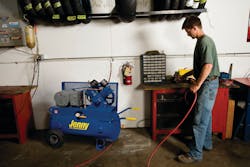Tips for Selecting the Right Hand-Carry or Wheeled-Portable Compressor
Hand-carry and wheeled-portable air compressors can add extra convenience around the shop. Rather than dragging long air hoses from a stationary unit, a person can simply bring the air source to where it’s needed - whether inside or outside a facility.
The main concern is whether these portable units have the capacity to meet a shop’s needs. Here are several selection tips.
VOLUME
First, determine the capacity needed to do the job. Begin by adding the CFM (cubic feet per minute) requirements for all the tools that will be used simultaneously. Then, add another 30 percent of that to allow for unknown or uncommon compressor usage.
The CFM ratings can be found either on the air tools themselves or in the owner’s manual. The number can be figured three ways:
1. Displaced CFM (DCFM). This is simply a mathematical calculation of the bore, stroke and rpm. However, it does not take into account any of the important variables, like temperature, atmospheric pressure, humidity, friction or heat dissipation, and therefore it means almost nothing in the real world.
2. Standard CFM (SCFM). This is a better measure of reality. SCFM is the flow of free air in a standardized environment - such as 14.5 psi atmospheric pressure (the pressure at sea level), 68 degrees Fahrenheit and 0 percent humidity. This is a standardized metric, so it’s the best figure to use in comparing air compressors across the board, apples to apples.
But what about individual needs? For instance, if it’s July in Louisiana, the humidity is going to be much higher than 0 percent.
3. Actual CFM (ACFM). This figures in the variables that apply to unique situations. It will provide the output of the pump for the actual working conditions. But ACFM is a hard figure to get, precisely because it does require site-specific data and calculations that may be best left to an engineer.
So for selection purposes, the best bet is to compare air compressors based on the SCFM ratings. Note, too, that CFM is often shown at various pressures. These numbers can be very useful to determine if a compressor produces enough volume for the application, but they can be confusing when trying to compare different compressors or compressors rated at different pressures.
Again, SCFM is best as it levels the playing field.
OPERATING PRESSURE
CFM will also be important to know when considering a single-stage compressor versus a two-stage model. List the minimum operating pressure requirements for the tools that will be used to indicate whether a single-stage or two-stage compressor is needed. Single-stage compressors are fine up to 150 psi. Anything over 150 psi requires a two-stage.
A single-stage compressor will typically have a higher CFM rating because the cylinder is drawing in air and compressing it with every rotation. A two-stage is compressing the air up to an intermediate pressure in one or more cylinders and then passing it on to another cylinder to finish the job.
Because the air is typically passed through an intercooler between stages, a two-stage compressor is more efficient at higher pressures.
Keep in mind that hand-carry units are not available in two-stage.
RECEIVER TANK
When choosing a portable compressor, the size of the air tank also makes a difference. If a person is running tools that require quick, concentrated bursts of air, a small tank is best. If the tools are to be used for sustained periods, such as impact wrenches, a larger tank will work better.
It’s like blowing out a candle compared to blowing out a birthday cake covered with them. A deep breath is needed to blow out the birthday cake; the candle can be blown out with a puff.
QUALITY
No matter the size or rating of a compressor, durability is key. Durability means longevity, and longevity means cost-efficiency over time. Invest in quality up front and it will pay dividends for years to come.
Look for long-term durability features, such as a cast-iron cylinder; a heat-dissipating head; an efficient cooling system; structural protection for critical components and fittings; a heavy-duty steel frame; and powder-coat or electrostatically applied paint to resist chipping and wear.
Anti-vibration feet will help keep the noise down and, more importantly, keep the compressor from rattling itself apart.
SUPPLIER COMPANY, PARTS AND SERVICE SUPPORT
Asking questions helps determine quality factors that can't necessarily be seen. Are air compressors the primary or sole business of the supplier? Does the company make its own products or source them from a third party?
How long has the company been in the air compressor business? (All we know about the future is what we know about the past, so look at the company’s history in this market.)
Can the supplier answer questions clearly and explain the subtleties that only an expert would know? What about the availability of technical help, parts and service and the distribution network?
INITIAL PRICE AND LONG-TERM COSTS
When adding it all up, what will the cost be over time? Consider how the compressor will be used, how often and how long. The big question in the selection decision is this: What would it cost to be wrong?
Ultimately, what you’re buying is not just an air compressor. What you’re really buying is a solution to your problem.
By considering all factors, you can find a hand-carry or wheeled-portable unit that will not only meet your needs, but also provide the portability you desire. And that concept is a breath of fresh air.
Dan Leiss is president of Jenny Products. With roots dating back to the 1870s, the company is a manufacturer of hand-carry, wheeled-portable and industrial-stationary air compressors. www.jennyproductsinc.com.
